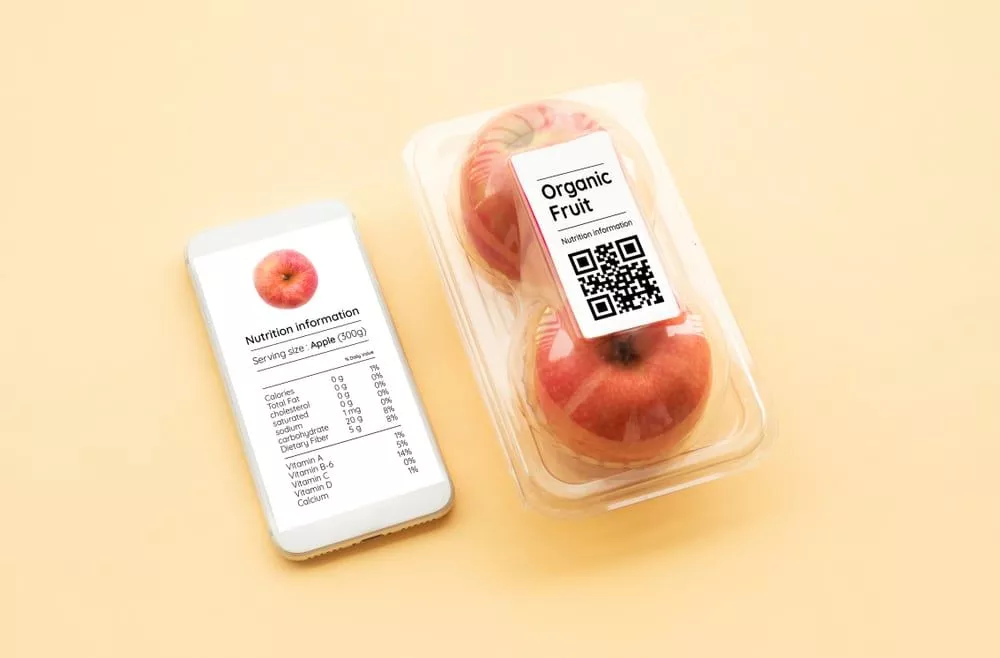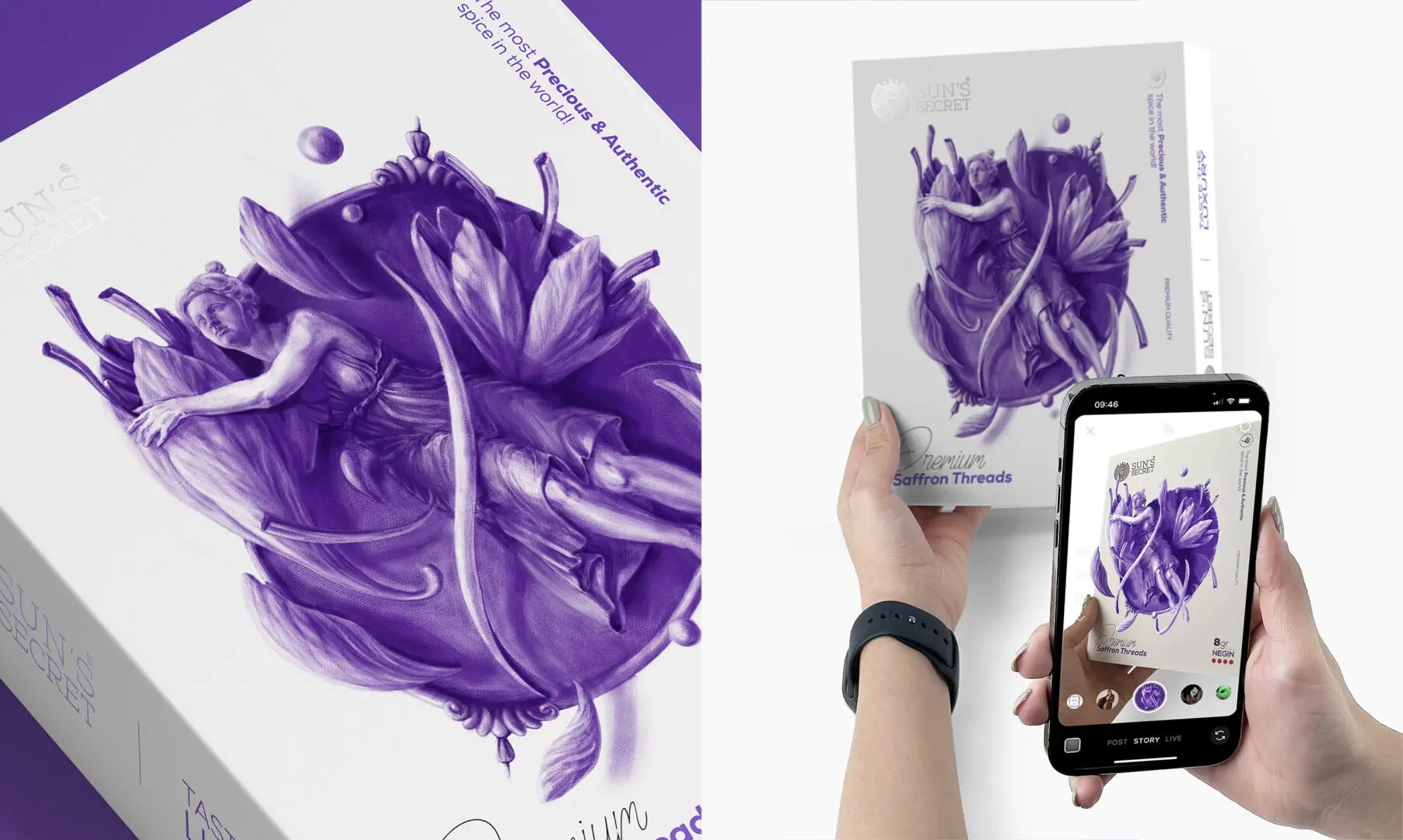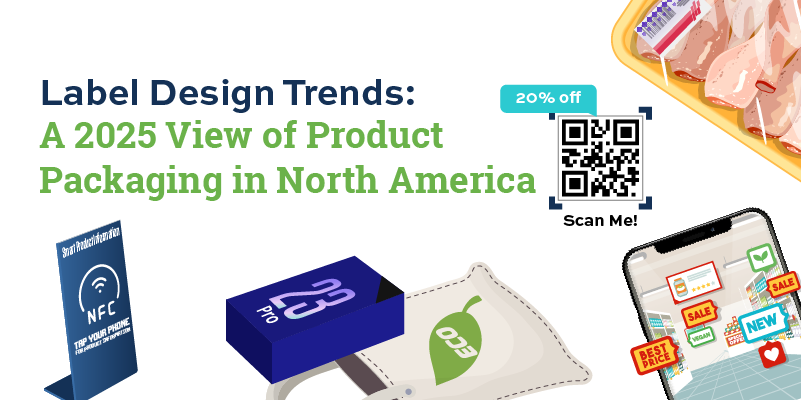Label Design Trends: A 2025 View of Product Packaging in North America
As the retail market becomes more saturated with a myriad of products, brands must learn how to differentiate themselves. Product packaging is one way to stand out, as well-executed designs in ecommerce packaging, for instance, have the power to influence purchasing decisions. This applies to product labels as well.
The packaging industry is ever-evolving, with new trends arising every year and no longer applying to simply the packaging label’s aesthetics. Sustainability, safety, and technology are major considerations among today’s consumers, so placing value on these factors should be a priority for brands.
If your brand is looking to innovate their product label designs, this infographic will help you navigate key trends in the shifting packaging and labeling landscape.
Jump to a Section
- Key Product Label Design Trends
- Safety and Transparency Trends in Product Label Designs
- Sustainable Product Label Design Trends
- Product Label Design Technology and Future Trends

Key Product Label Design Trends
Staying knowledgeable of the latest trends is crucial for businesses in any industry. Here are notable product label design trends across key sectors.
1. Food and beverages
In the food and beverage sector, there’s a noticeable shift towards vibrant, illustrative designs that effectively communicate freshness and quality. Brands are also adopting minimalist packaging adorned with clean typography, often featuring natural color palettes.
For instance, organic food products are leveraging earthy tones and botanical illustrations to convey a sense of purity and healthiness. The emphasis on transparency through clear and concise labeling, highlighting ingredients and nutritional information, caters to the growing consumer demand for healthier and organic choices.
2. Cosmetics
Sleek and minimalistic designs continue to dominate the cosmetic industry. Brands are focusing on clean, elegant cosmetics packaging with bold typography that exudes sophistication.
Personalized packaging is gaining ground, allowing brands to create a unique and exclusive connection with consumers. Imagine a cosmetic line offering personalized labels with the customer’s name or a special message, elevating the overall user experience and fostering brand loyalty.
3. Clothing
The apparel sector is witnessing a departure from traditional rectangular labels, with brands exploring unconventional shapes and materials. Sustainable and eco-friendly materials are gaining traction, reflecting a heightened awareness of environmental concerns within the fashion industry.
Clothing labels made from recycled or biodegradable materials, for example, contribute to a brand’s commitment to sustainable practices. These innovative designs resonate with eco-conscious consumer preferences and serve as a testament to a brand’s values.
4. Pharmaceuticals
The pharmaceutical industry is moving towards more informative and user-friendly aesthetics. Clear typography, color-coded information, and an emphasis on safety features are becoming standard practices.
Braille labels are increasingly incorporated for enhanced accessibility, ensuring that crucial information is accessible to visually impaired consumers. QR codes are being utilized to provide quick access to detailed product information, dosage guidelines, and potential side effects, enhancing the overall user experience.
5. Consumer electronics
With rapid technological advancements, consumer electronics labels are embracing a futuristic look. Clean lines, bold contrasts, and the incorporation of QR codes or augmented reality (AR) elements for interactive user guides are becoming prevalent.
For instance, a smartphone’s label features a QR code that, when scanned, provides users with instant access to a virtual guide showcasing product functionalities and troubleshooting tips. This enhances user engagement and aligns with the tech-savvy expectations of modern consumers.
Safety and Transparency Trends in Product Label Designs
In today’s consumer-centric market, safety and transparency have become paramount considerations for product labels across diverse industries. The following are product label trends shaping safety and openness, influencing consumer trust and purchasing decisions.

1. Clear ingredient communication
Safety-conscious consumers are demanding greater clarity regarding the ingredients used in products. Brands are responding by incorporating clear and concise ingredient lists on their labels. In the food industry, for example, labels not only list ingredients but also highlight allergens prominently.
Similarly, skincare and cosmetic labels are adopting standardized ingredient terminology to ensure consumers can make informed choices about the products they apply to their bodies.
2. Allergen warnings and icons
With the rise in allergies and dietary restrictions, labels are now featuring prominent allergen warnings and icons. Food labels, in particular, are incorporating universally recognized symbols to indicate the presence of common allergens like nuts, gluten, or dairy. This trend contributes to consumer safety while streamlining the shopping experience for those with specific dietary needs.
3. QR codes for detailed information
QR codes are increasingly utilized as a tool for providing detailed product information, especially when space on the label is limited. For instance, pharmaceutical labels often include QR codes that, when scanned, lead consumers to comprehensive online resources detailing usage instructions, potential side effects, and safety precautions. This approach empowers consumers with access to extensive information.
4. Sustainability certifications
Transparency in product labels extends to environmental sustainability. Brands are prominently showcasing certifications such as “recyclable,” “biodegradable,” or “made from recycled materials.” This practice assures eco-conscious consumers of a brand’s commitment to sustainable practices, fostering trust and loyalty. An example is a clothing label proudly displaying a “sustainable fashion” certification, signaling the brand’s dedication to ethical and eco-friendly manufacturing processes.
5. Safety features
In the pharmaceutical sector, safety features are being incorporated directly into the label design. Tamper-evident seals and holographic elements provide visual cues to consumers, assuring them of the product’s integrity. Child-resistant packaging is another safety-oriented trend, particularly for medications. Labels on such products include clear instructions and icons to highlight these safety features, assuring consumers of the brand’s commitment to their well-being.
Sustainable Product Label Design Trends

Sustainability has emerged as a central theme in product label design. Industries are integrating environmentally friendly elements into labels to reflect a commitment to sustainable practices. Here are the evolving trends in sustainable product label design across various sectors.
1. Recyclable and biodegradable materials
One of the foundational trends is the shift towards labels made from recyclable or biodegradable materials. Brands across industries are opting for paper or biopolymer-based labels that can be easily recycled or broken down naturally, minimizing their environmental impact. This approach aligns with consumer preferences for products that consider the entire lifecycle, from production to disposal.
2. Minimalist design
The minimalist design trend has gained momentum as a sustainable choice. Labels with clean, simple layouts use fewer resources during production and contribute to a reduction in waste. This trend is prevalent in the cosmetics and personal care industry, where brands are opting for minimalist labels that convey essential information without excess packaging.
3. Water-based inks and soy-based printing
Traditional printing processes can involve environmentally harmful chemicals. Sustainable product labels are now incorporating water-based inks and soy-based printing, significantly reducing the environmental impact of the printing process. This shift ensures that labels convey information responsibly and are produced in an eco-friendly manner.
4. Eco-friendly adhesives
Sustainable labels are not limited to the face stock; attention is also given to the adhesive used. Brands are adopting eco-friendly adhesives that adhere well during product use but don’t hinder the recycling process. This trend ensures that the entire label, including the adhesive, contributes to a more sustainable end-to-end product lifecycle.
5. Smart labeling for extended product life
Brands are incorporating smart labeling technologies that provide real-time information about product freshness, storage conditions, and expiration dates. This reduces food waste by empowering consumers to make informed decisions about product usage. Consider a smart label on a food item indicating its remaining shelf life through color-changing indicators.
6. Upcycled label materials
The concept of upcycling and repurposing waste materials into new products has extended to label design. Brands are experimenting with labels made from upcycled materials, such as recycled paper or textile waste. This trend not only contributes to waste reduction but also adds a unique touch to the product.
Product Label Design Technology and Future Trends
Product label design is significantly influenced by technological advancements that redefine how brands interact with consumers. Here, we explore the latest technology-driven trends and future directions shaping product label design across diverse industries.

1. Augmented reality (AR) integration
AR technology is making waves in product label design by providing an interactive and immersive consumer experience.
Brands are incorporating AR elements into labels, allowing consumers to use their smartphones to unlock additional content, product information, or even virtual experiences. For example, cosmetic brands utilize AR labels to enable customers to virtually try out different makeup shades before making a purchase.
2. QR codes for enhanced engagement
Quick response (QR) codes continue to be a valuable tool for enhancing consumer engagement through product labels. By scanning QR codes, consumers gain access to detailed product information, promotional offers, or interactive content. This technology facilitates a seamless bridge between the physical label and digital experiences, fostering a deeper connection with the brand.
The traditional static QR code is evolving into dynamic QR codes that allow brands to update content even after the label is printed. This flexibility enables brands to adapt information based on seasonal promotions, product updates, or changing regulatory requirements. Dynamic QR codes ensure that the label remains relevant throughout the product’s lifecycle.
3. Near-field communication (NFC) for smart labeling
NFC technology is gaining prominence as a smart labeling solution. With a simple tap of a smartphone, consumers can access a wealth of information about the product. NFC-enabled labels are particularly useful in the pharmaceutical and food industries, where detailed information about ingredients, usage instructions, and authenticity can be crucial for consumers.
4. Smart sensors for real-time monitoring
The integration of smart sensors into product labels enables real-time monitoring of various conditions. For instance, food labels equipped with temperature sensors can provide consumers with assurance about the freshness and safety of the product. This technology ensures consumer safety and that products are used within optimal conditions.
Sustainable, Healthy, and Modern Living Through Product Labels
Product packaging continues to evolve, with consumers no longer concerned about aesthetics alone. Today, custom packaging solutions must consider various product label aspects, including sustainability, health, safety, wellness, and technological innovations. By familiarizing yourself with the latest industry trends, you can be more holistic in your packaging strategy.
Let Meyers be your trusted label supplier to address your business needs amidst ever-changing market demands. Learn more from our experts today.

